Photosynthesis in Higher Plants
Table of Content
- Define Photosynthesis
- Photosynthetic Membranes and Organelles
- Pigments involved in Photosynthesis
- Light Reaction
- Difference between Cyclic and non-cyclic Photophosphorylation
- Chemiosmotic Hypothesis
- Calvin Cycle
- C4 Pathway
- Photorespiration
- Crassulacean Acid Metabolism
- Factors Affecting Photosynthesis
Define Photosynthesis
It is defined as the process of conversion of light energy into chemical energy. The chemical energy is stored in the form of carbohydrates such as sucrose, starch etc. The reactants of photosynthesis include carbon-dioxide and water and the products are carbohydrates and oxygen. The overall reaction for photosynthesis is given below-
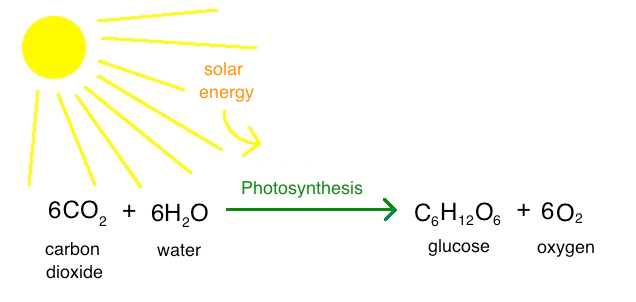
Fig.1. Overall reaction of photosynthesis
Photosynthetic Membranes and Organelles
In higher plants, photosynthesis occurs in chloroplast. Chloroplast is a double membrane structure. There are about 10 to 100 chloroplasts found in plant cell. The outer membrane and the inner membrane are separated by intermembrane space. Membrane enclosed a fluid known as stroma. Stroma contains membrane bound structures known as thylakoid. The stacks of thylakoid are known as granum.
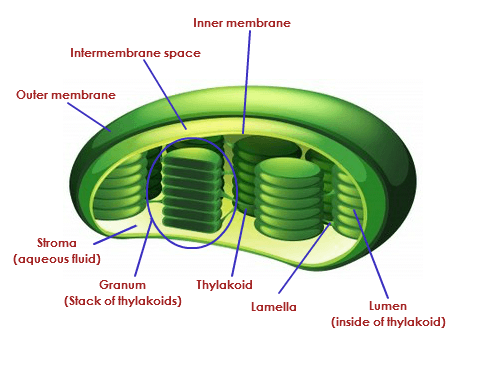
Fig.2. Structure of chloroplasts
One granum is connected to another granum by lamella. Reactions which need light are known as light reactions. The site for light reactions is granum. Light independent reactions are known as dark reactions which takes place in the stroma of the chloroplast.
Pigments involved in Photosynthesis
The pigment present in chloroplast is chlorophyll. Chlorophyll absorbs the sunlight during photosynthesis. It absorbs light mainly from the blue portion of electromagnetic spectrum. Magnesium is the metal ion essential for chlorophyll formation. It comprises of phytol chain and pyrrole ring. Leaves appear green due to the presence of chlorophyll.

Fig.3. Structure of chlorophyll
Other pigments observed during chromatographic separation are – chlorophyll a, chlorophyll b, carotenoids, and xanthophyll. Chlorophyll a appears blue or bright green in paper chromatogram, chlorophyll b appears yellow green, xanthophyll appears yellow and carotenoids appear yellow- orange. Different plant pigments absorb different wavelength of light.
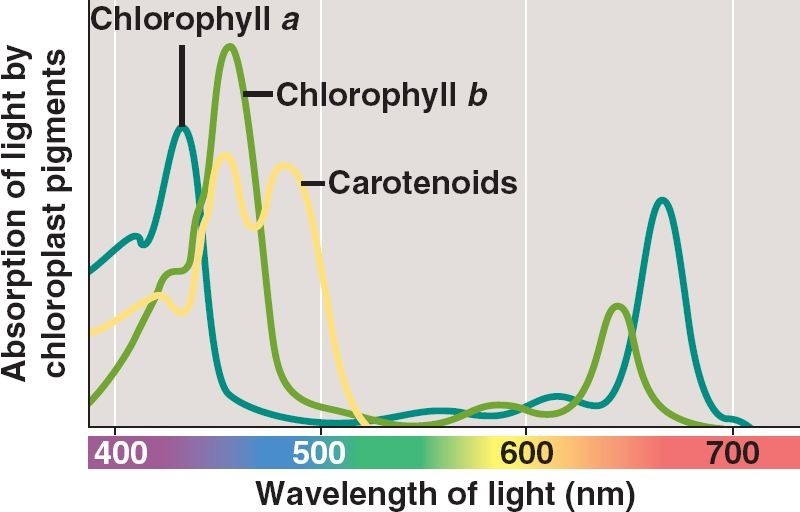
Fig.4. Absorption spectra of different plant pigments
Light Reaction
Light dependent reactions begin with the absorption of photon by the chlorophyll. The pigments are organized into different photosystems. There are two photosystems that are essential for light reactions. Photosystem I (PSI-700) and photosystem II (PSII-680). 700 and 680 represents the absorption spectra for PSI and PSII respectively.
Photosystem comprises of certain proteins, chlorophylls, iron-sulphur centers etc. The single chlorophyll molecule is considered as reaction center where light is absorbed. Light reactions include cyclic photophosphorylation and non-cyclic photophosphorylation.
Non-cyclic photophosphorylation
It includes both the photosystem, that is, PSI and PSII. It begins with the absorption of photon by the PSII which is accompanied by ejection of two electrons. The primary electron acceptor in non-cyclic photophosphorylation is pheophytin. Electrons are then accepted by plastoquinone A (QA) followed by plastoquinone B (QB). Then the electrons are accepted by cytochrome b6f. Then the electrons are accepted by plantocyanin (copper containing pigment). Then PSI accepts the electron and passes to Fe-S center. Then electrons are transferred to Ferredoxin-NADP+ reductase where NADPH is formed.
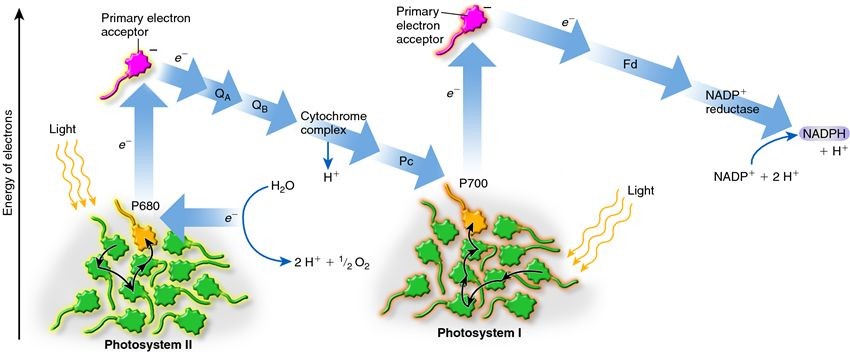
Fig.5. Non-cyclic photophosphorylation
During non-cyclic photophosphorylation protons are also pumped into the thylakoid to create a proton gradient for driving ATP synthesis.
The most important reaction that occurs at PSII is photolysis of water. Manganese, chloride ions are essential for photolysis. It is a light dependent reaction that yields oxygen, proton and electrons.
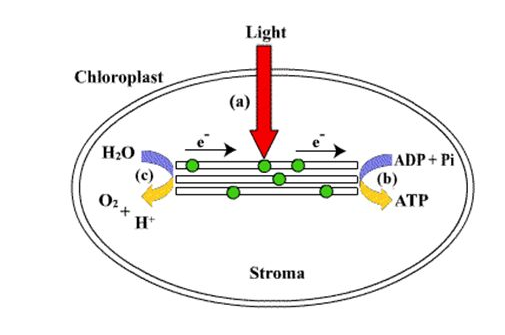
Fig.6. Photolysis of water
Cyclic photophosphorylation
It involves only one photosystem, that is, PSI. During this cycle, electron passes from PSI to primary electron acceptor, pheophytin. Then to cytochrome b6f to plastocyanin before coming back to PSI. There will be no photolysis of water occurs during cyclic photophosphorylation. No NADPH is formed but ATP formation will occur.
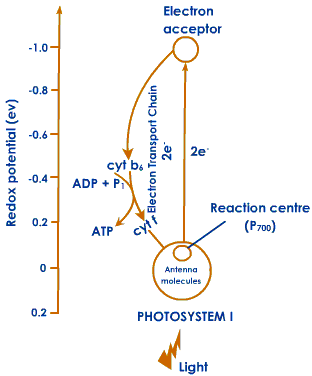
Fig.7. Cyclic photophosphorylation
Difference between Cyclic and non-cyclic Photophosphorylation
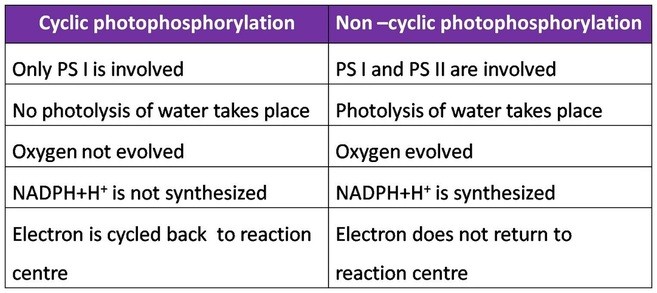
Chemiosmotic Hypothesis
Chemiosmotic hypothesis explains how ATP synthesis occurs. It is based on the hypothesis that Proton gradient drives ATP synthesis. Steps that are involved in setting the proton gradient-
- Splitting of the water molecule (photolysis of water) during light reactions pumps the protons within the lumen of the thylakoid.
- When electrons move through photosystems, protons are pumped across the membrane.
- The NADP reductase enzyme located on the stromal side also pumps the protons across the membrane.
All the above processes are responsible for the establishment of proton gradient. Stroma contain more protons as compared to the lumen of the thylakoid. This also creates a pH difference between the lumen and the stroma. To breakdown the gradient, protons move across the membrane to the stroma through F0-F1 ATPase.
The ATPase enzyme comprises of two parts- Fo which is embedded in the membrane and provides a channel for the pumping of the protons across the membrane. The other part is F1 which faces the stroma and protrudes out of the membrane. Chemiosmosis requires a membrane, a proton pump, a proton gradient, and ATPase complex. Energy is used to pump protons across a membrane, to create a gradient within the thylakoid lumen. ATPase has a channel that allows diffusion of protons back across the membrane which releases enough energy to activate ATPase enzyme that catalyzes the formation of ATP.
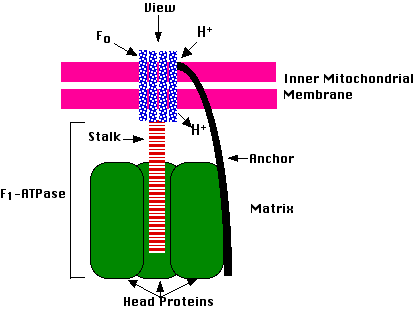
Fig.8. ATPase complex
Calvin Cycle
The ATP and NADPH formed during light reactions are used for the biosynthetic phase of photosynthesis. This phase is known as Calvin cycle or dark phase. It is a light independent reaction that takes place in the stroma of the chloroplast. It is used for the fixation of carbon-dioxide in the form of carbohydrates.
The primary electron acceptor during Calvin cycle is RuBP (ribulose bisphosphate). It has both carboxylase and oxygenase activity. RuBP (a five-carbon substrate) reacts with CO2 in the presence of enzyme RuBisCO to produce 3-PGA (3- phosphoglycerate).
It catalyzes the first reaction of Calvin cycle.
It includes three steps- carbon-fixation, reduction, and regeneration.
- Carboxylation or carbon-fixation include a reaction between carbon-dioxide RuBP to form two molecules of 3-phosphoglyceric acid.
- Reduction include the conversion of 3-phosphoglyceric acid to 3-phosphoglyceraldehyde using both ATP and NADPH.
- Regeneration includes the formation of RuBP using ATP so that cycle continues without interruption.
So for every carbon-dioxide molecule that enters the cycle 3 molecules of ATP and 2 molecules of NADPH are required. So 6 rounds of cycle will consume 18 ATP and 12 NADPH.

Fig.9. Calvin cycle
C4 Pathway
C4 pathway also known as Hatch and Slack pathway after the name of the scientist who discovered it. Plants which are adapted for dry tropical regions undergo C4 pathway for carbon fixation. For example, maize. Sorghum. The characteristic feature of this pathway is Kranz anatomy. Kranz anatomy comprises of two types of cells- mesophyll cells and bundle sheath cell as compared to Calvin cycle where only mesophyll cells are found.
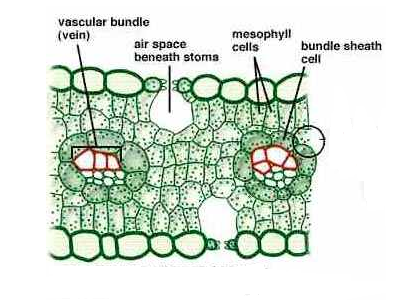
Fig.10. Kranz Anatomy
The cells of kranz anatomy are characterized by large number of chloroplast, thick walls with no intercellular spaces. The primary carbon-dioxide acceptor during C4 cycle is phosphoenol pyruvate (PEP). PEP is present in mesophyll cells. But mesophyll cells lack RuBisco. Atmospheric carbon-dioxide reacts with PEP to form oxaloacetic acid in mesophyll cells. This is then transferred to bundle sheath cells where oxaloacetic acid undergo de-carboxylation to form malic acid. The carbon-dioxide released is entered into the Calvin cycle. The malic acid formed is used for the regeneration of phosphoenol pyruvate.

Fig.11. Hatch and Slack pathway or C4 cycle
Photorespiration
Ribulose bisphosphate possess affinity for both carbon-dioxide and oxygen. Though the affinity of RuBisco is high for carbon-dioxide as compared to oxygen, sometimes RuBisco binds oxygen which decreases the carbon-dioxide fixation. Instead of forming 3-phosphoglyceric acid (3-PGA), it forms one molecule of phosphoglycerate and phosphoglycolate. This pathway is known as photorespiration. Three cell organelles are involved in photorespiration- chloroplast, peroxisomes and mitochondria.
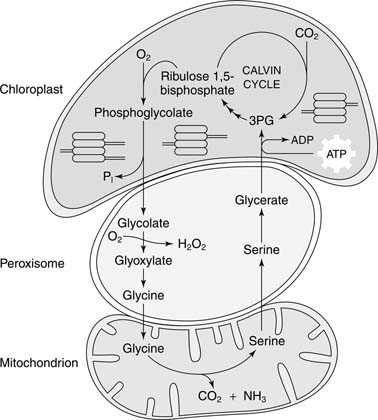
Fig.12. Photorespiration
During photorespiration, neither ATP nor sugar are synthesized. It is considered as waste process as it utilizes ATP and releases carbon-dioxide. Photorespiration is feature of C3 plants but not C4 plants. So, productivity and yield in high in case of C4 plants as compared to C3 plants. C4 plants also work efficiently during high temperature.
Crassulacean Acid Metabolism (CAM) (CAM)
CAM pathway is adapted for arid conditions. In normal case, stomata are open in day time for photosynthesis. But in plants adapted for arid conditions, stomata open during night time for taking in carbon-dioxide. The carbon-dioxide is stored in the form of malate in night. The malate is fixed using PEP carboxylase similar to C4 pathway. During the night time, this malate is decarboxylated to form pyruvate. The carbon-dioxide evolved enters into Calvin cycle for carbon-dioxide fixation.
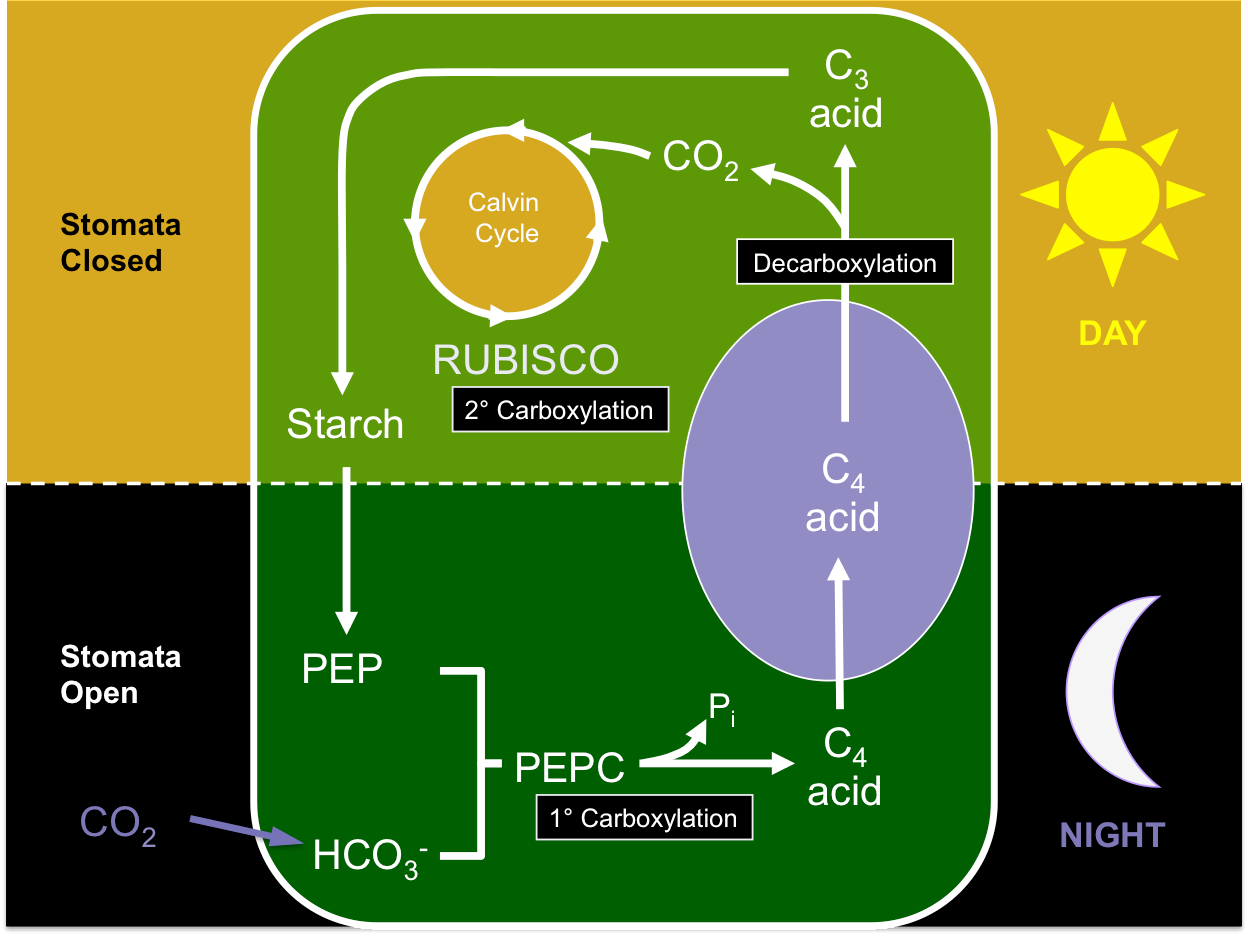
Fig.13. Crassulacean acid metabolism pathway
This pathway is advantageous for plants adapted for arid conditions. It prevents the loss of water in the form of transpiration.
Factors Affecting Photosynthesis
- Light intensity and duration of light affects the rate of photosynthesis. Increase in light intensity increases the rate of photosynthesis but after a particular intensity, rate of photosynthesis will not increase any more.
- Carbon-dioxide concentration is another factor that affects the photosynthesis. Increase in carbon-dioxide concentration increases the rate of photosynthesis but beyond 0.05% increase will cause a decrease in rate of photosynthesis. C3 and C4 plants respond differently with carbon-dioxide concentration.
- Temperature is another factor affecting the photosynthesis. Light reactions are less sensitive to temperature. C4 plants work efficiently at higher temperature as compared to C3 plants.
- Water is another limiting factor during photosynthesis. Less water closes the stomata and thus decreases the productivity of carbon fixation.